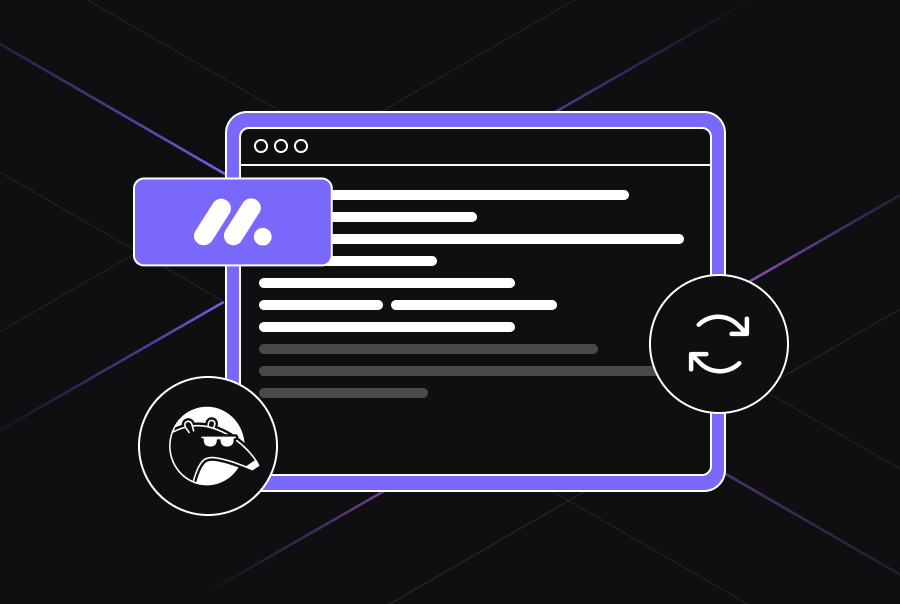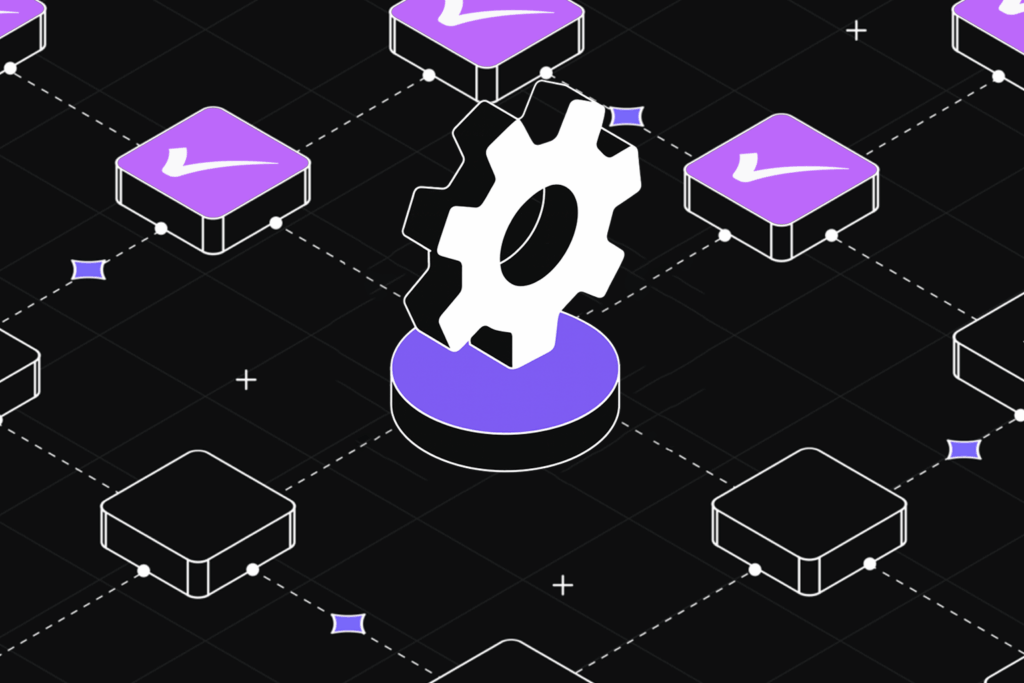Technical Debt and AI: Understanding the Tradeoff and How to Stay Ahead
TL;DR
- Technical debt builds up when intermediate hacks or temporary solutions are taken during software development. Even small decisions, like bypassing a cache bottleneck, can lead to major outages, slow feature delivery, and weaken customer trust over time.
- Approximately 40% of developers spend 2–5 working days per month on debugging, refactoring, and maintenance caused by technical debt. AI code reviews can reduce this time by detecting early duplication, outdated patterns, and architectural inconsistencies, helping teams maintain production-ready, maintainable code.
- Code duplication and poor reuse are growing problems i.e., AI-generated snippets often encourage copy-paste practices instead of thoughtful refactoring, creating bloated, fragile systems that are harder to maintain and scale.
- Context-aware AI code review platforms like Qodo provide a “last mile” solution, catching subtle issues that standard AI tools or AI IDE checks miss. Qodo analyzes dependencies, architecture, and logic, prioritizes fixes, ensures best practices, and enables one-click remediation to prevent hidden technical debt.
- Shift-left, real-time reviews with Qodo let teams identify structural, security, and duplication problems early. This approach supports fast AI-assisted development while preventing hidden technical debt, ultimately improving reliability and sustaining long-term code quality.
A few months ago, I was called in for a late-night incident after our payments service started throwing ‘503 Service Unavailable’ errors. Initially, it looked like a database connection spike. Still, when I researched this, the issue traced back to a “temporary” in-memory cache layer someone had added six months earlier to bypass a latency bottleneck. It was supposed to be replaced with a proper Redis-backed cache, but because it “worked,” it never got rewritten.
That single shortcut, which was meant to buy us time, instead delayed transactions for hours and cost us customer trust and delivery speed. That’s technical debt in its purest form: yesterday’s convenience becoming today’s liability. In simple terms, technical debt is the implied cost of choosing a quicker, easier solution today that leads to rework and risks in the future.
Gartner estimated that over 40% of IT budgets are consumed by dealing with technical debt, and a Deloitte survey showed 70% of tech leaders believe tech debt is slowing down digital transformation initiatives.
As a Head of Engineering, I have seen tech debt show up in various forms, such as duplicate logic scattered across services, fragile modules no one wants to touch, or performance bottlenecks that appear only at scale. In financial terms, it’s the “interest” you pay on yesterday’s shortcuts and its impact on long-term code quality.
And it’s no brainer that teams are using AI more than ever. AI can help teams code faster, but it also opens the door to more “shortcuts.” AI doesn’t have context or a deep understanding of your codebase; it only predicts patterns. Tools like Qodo analyze code in the context of your system’s architecture and production-readiness, whereas AI often generates code that looks correct but misaligns with long-term quality. That means it can assume things independently: pulling in redundant logic, ignoring domain-specific constraints, or generating code that looks fine but misaligns with enterprise standards.
The 2025 Stack Overflow Developer Survey found that 84% of developers are using or planning to use AI coding tools, with over 50% relying on them daily. GitHub Copilot’s usage data reports that AI generates over 35% of developers’ code in popular languages.
That’s why I believe the conversation about tech debt has shifted. It’s no longer just about cleaning up legacy systems but building guardrails for the AI era. Let’s understand what tech debt is in detail and how AI-generated code is compounding it. We’ll also see how team leads reduce tech debt across their teams with context-aware AI code reviews like Qodo ( and why they are more efficient than manual reviews).
What is Technical Debt?
Technical debt refers to the hidden cost development teams carry when taking shortcuts during software delivery. These shortcuts may help ship features faster in the short term, but often create gaps in code quality, security, or maintainability. Over time, these gaps accumulate and demand significant effort to fix, much like financial debt that accrues interest.
Recent data shows how this problem is worsening in the AI era. GitClear’s second annual AI Copilot Code Quality report analyzed more than 211 million changed lines of code between 2020 and 2024 across private repositories and major open-source projects. Their findings revealed clear signs of declining code quality. The research warned that AI’s short-term speed often leads to long-term risks.
How Reduced Refactoring Increases Technical Debt
One of the key principles of managing technical debt is ensuring that code is maintainable and reusable. Unfortunately, recent trends show a worrying shift.
GitClear reported an eightfold increase in code blocks containing five or more duplicated lines, compared to just two years earlier. This points to a surge in copy-paste practices, with duplication becoming ten times more common. That same year, 46% of all code changes were entirely new, while copy-pasted lines surpassed “moved” lines.
The concept of “moved” lines, as defined by GitClear, refers to reorganizing existing code to consolidate logic into reusable modules. According to Bill Harding, CEO of Amplenote and GitClear, code movement is one of the clearest signs of healthy refactoring and reuse.
The decline in code movement and rising duplication show that developers highly favor copy-paste over thoughtful reuse. This matters for technical debt because each duplicated or poorly refactored block introduces redundancy, complicates maintenance, and increases the cost of future changes.
In my experience, teams relying heavily on AI-generated code are especially vulnerable. AI often generates working snippets that get copied and pasted across modules without consideration for consolidation, creating a hidden layer of technical debt that grows silently over time.
I have shared a chart on Code Operations and Code Churn by Year by GitClear below:

The chart, Code Operations and Code Churn by Year (GitClear Code Quality Research 2025), visualizes how different types of code changes have evolved from 2020 to 2025 (with a projection for 2025).
- Added code (blue line) is steadily rising, nearing 50% of all changes, showing teams are writing more new code every year.
- Moved code (green line) is falling sharply, approaching near zero by 2025. This means developers are reusing or reorganizing existing work far less often.
- Copy/pasted code (orange-red line) is rising significantly, surpassing the moved code around 2022 and continuing to grow. This highlights a strong trend toward duplication.
- Churn (brown line), which measures code that is added and then quickly modified or deleted, is climbing steadily, projected to hit nearly 7% by 2025. This is a red flag for instability and rework.
- Other operations (deleted, updated, find/replace) remain relatively flat but show slight increases.
The overall picture confirms the narrative: developers (and AI assistants) add and copy more, while reorganizing and reusing less. This shift speeds up technical debt by creating bloated, fragile codebases with higher maintenance costs over time.
When “Easy with AI” Becomes Expensive Later
I went through a reddit post discussion about how AI can compound tech debt and came across this experience shared by a developer. Here’s a snapshot of his comment:
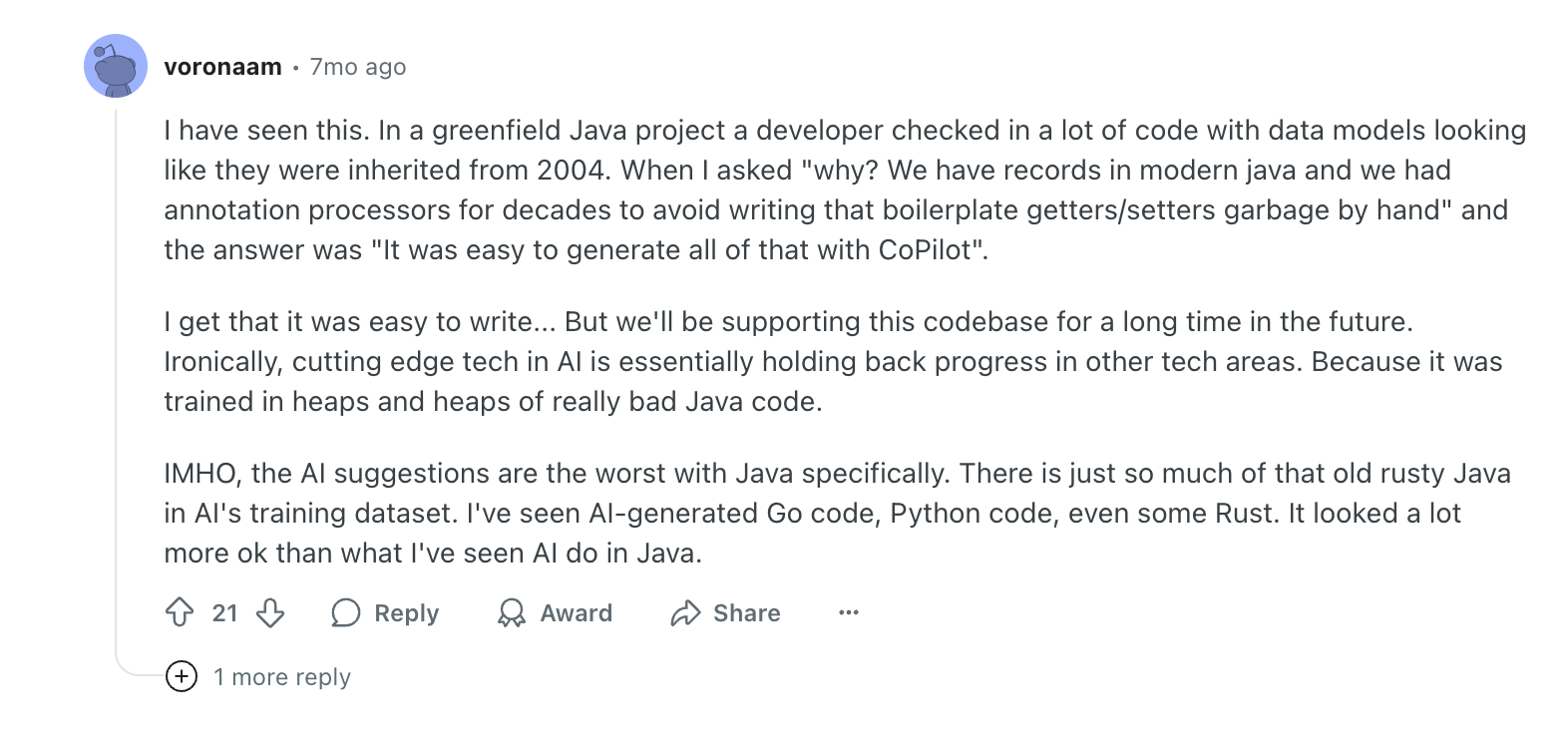
A developer shared an experience from a greenfield Java project where a teammate used AI tools like GitHub Copilot to generate much boilerplate code, things like getters and setters that modern Java practices had already replaced with annotation processors. The AI-generated code looked fine initially, but it introduced outdated patterns that will make the codebase harder to maintain in the long run.
The irony is that while AI is seen as cutting-edge, it often reproduces old and poor coding habits because of the data it was trained on. In this case, AI suggestions pulled the project back toward practices abandoned years ago instead of speeding up progress.
The irony is that while AI is seen as cutting-edge, it often reproduces old and poor coding habits. The developer also noted that Java suffers the most from this problem, which is why teams should consider using Java code review tools to catch outdated practices early. By comparison, AI-generated Go, Python, or Rust code often looks cleaner and more aligned with current standards.
Types of Tech Debt
Before diving into how technical debt accumulates and affects projects, it’s important to understand that not all tech debt is created equal. Broadly, technical debt can be categorized into two main types: Planned and Unplanned. Recognizing their differences helps teams manage debt effectively and avoid long-term pitfalls.
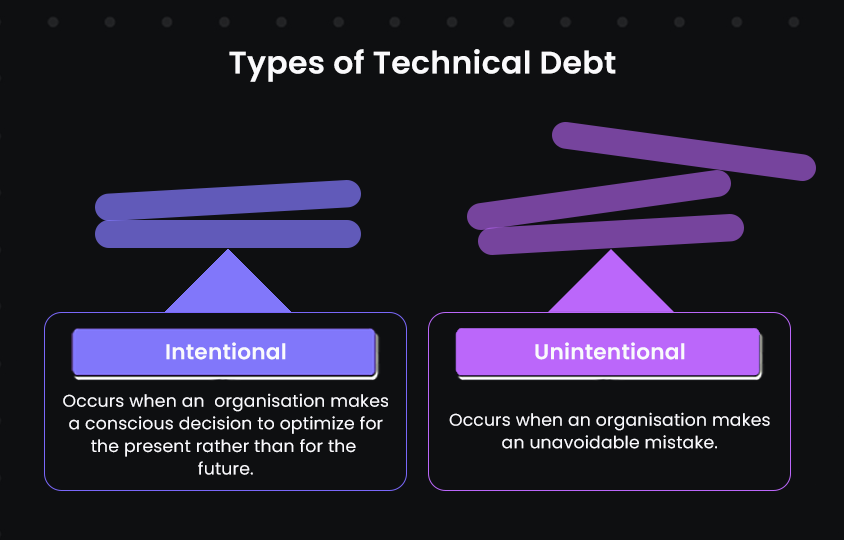
Intentional (Deliberate) Technical Debt
Intentional or Planned technical debt happens when teams knowingly take shortcuts for speed, usually to meet a deadline or deliver a feature faster. It’s not inherently bad if it’s documented and later paid back by refactoring or improving the system.
For example, consider Netflix in its early days of moving to cloud infrastructure. To speed up migration, engineers deliberately cut corners using simpler solutions instead of building the most scalable ones immediately. The goal was to move fast and keep the service running. Later, they went back, rewrote services, and optimized for scale. This was intentional debt; they knew what they owed and why.
Unintentional (Inadvertent) Technical Debt
Unintentional or Unplanned technical debt is the opposite; it accumulates because of poor design decisions, lack of understanding, or reliance on tools (like AI code generation) without context. Teams don’t realize they’re creating problems until the system starts breaking or becomes too complex to maintain.
For example, in 2021, Robinhood (the stock-trading app) faced massive outages during high trading volumes, especially during the GameStop surge. Much of this was traced back to legacy code, scaling issues, and infrastructure choices that were never designed for such spikes. This was unplanned debt, accumulated over time because engineers didn’t anticipate extreme growth or stress scenarios. They weren’t cutting corners deliberately, but the lack of foresight created debt that had to be urgently “paid off” under pressure.
How AI-Generated Code Accelerates Technical Debt
In the previous section, we explored the two primary types of technical debt: planned and unplanned. While both can hinder software development, unplanned technical debt often comes from unforeseen issues. However, with the increasing use of AI-generated code, a new dimension of technical debt is emerging, subtle, pervasive, and often overlooked.
Most AI tools do not have a deep understanding of your codebase. They generate code without context, without insight into the architecture, business logic, or long-term maintainability. So, the code they produce may work in isolation, but it rarely meets the standards of a top-quality, production-ready system.
Let me walk you through the Tech Debt Loop that mostly happens with teams today:

The cycle begins with an AI output that looks fine at first review. Because the code is syntactically correct, it often gets merged into the codebase without much scrutiny. Over time, this adds layers of complexity that increase technical debt, as the code often fails to reflect the system’s specific architecture or long-term maintainability.
When issues emerge, teams often use AI to fix them, introducing further patches that add to the problem rather than resolving it. As a result, hidden issues accumulate, and reliance on AI grows, leading to an ever-expanding pool of AI-generated code. This creates a loop where debt compounds silently, making it harder to detect and address than traditional, planned debt forms.
This accumulated debt has real consequences. Even if the application appears production-ready, the hidden complexities and inconsistencies introduced by AI-generated code increase maintenance costs, slow future development, and create fragile systems that are harder to scale.
Lack of Contextual Understanding
Most LLMs lack the deeper understanding of business logic and system architecture that human developers have. This can lead to syntactically correct solutions that are semantically flawed, necessitating extensive rework.
Our AI assistant suggested a generic authentication method during a project to integrate a third-party payment gateway. While the code was syntactically correct, it didn’t align with our security protocols. This oversight required a complete rewrite of the authentication module, consuming valuable development time and resources.
Hidden Security Vulnerabilities
AI-generated code can appear correct at first glance, but it may introduce subtle security flaws that go unnoticed until they cause serious problems. For example, CrowdStrike’s research on the AI coding tool DeepSeek found that it produced a 42.1% error rate for certain sensitive applications, nearly double the 22.8% error rate typical of manually written code. These errors included insecure handling of inputs, weak encryption practices, and improper validation.
In an e-commerce platform, an AI-generated sorting algorithm for product listings worked flawlessly under normal conditions. However, it failed when products had multiple categories or were out of stock. These edge cases led to incorrect product displays, affecting user experience and sales.
Code Understanding and Reviews: The Last Mile Problem
In development workflows, especially in enterprise environments (like fintech platforms, e-commerce systems, or large SaaS products), the pile of branches, AI-assisted pull requests, and fast feature releases has made the code review process an important “last mile” in ensuring software quality.
The last mile refers to the final validation stage before code is merged into the main branch, essentially the last line of defense determining whether a change is truly production-ready. While AI can speed up coding and suggest fixes, it cannot guarantee its own context-aware, maintainable, or secure code. That responsibility rests on a thorough code review.
Consider the Git PR gate, the pull request approval process, as the enterprise choke point. This is where code is scrutinized for correctness, maintainability, and alignment with business logic. If teams fail to use this gate effectively, even AI-generated code that looks correct can introduce systemic risks. Following code review best practices ensures that reviews remain consistent and aligned with architectural expectations.
How Shift-Left Rationale Helps in Code Reviews?
The shift-left approach emphasizes catching issues early, during development, in IDEs, or via automated CI/CD checks, rather than relying solely on late-stage testing. Shift-left tools are invaluable, but they cannot replace human judgment.
They reduce trivial errors, but detecting context-specific problems, architectural misalignment, or improper reuse still requires informed review. Shift-left speeds up development, but the last mile review ensures quality, maintainability, and production-readiness.
How AI Code Reviews Help with Tech Debt
The more AI-assisted code is written, the greater the risk of accumulating technical debt, and the more thorough the review process must be to maintain the codebase.
Traditional code reviews have always depended on human attention, and that level of attention can vary person to person, or for each review cycle. This can also depend on the perceived level of complexity or understanding of the code being reviewed at the time. Developers’ efficiency and productivity also suffer when much of their time is spent supporting systems and reducing technical debt. According to JetBrains’ Developer Ecosystem Survey, over half of developers dedicate 1–5 working days per month to reviewing and addressing technical debt:
- 17% spend one day or less per month
- 40% spend 2-5 days per month
- 8% spend 6-10 days per month
AI-assisted code reviews can significantly reduce the time developers spend on technical debt. Tools like Qodo can recognize patterns across the entire codebase, identifying duplication, architectural inconsistencies, or risky coding practices that might be missed in individual reviews.
Code Reviews Across the SDLC
Code review is no longer confined to a single pull request. Modern best practices extend the review process across the entire software development lifecycle, from initial coding to post-merge monitoring, ensuring code quality at every stage.
The process can be thought of in three phases:
- Shift-Left (IDE/CLI): At the earliest stage of development, issues are caught and addressed directly in the IDE or via the CLI. Intelligent, real-time code analysis helps prevent problems from ever reaching the pull request stage. Developers receive immediate feedback and automated suggestions, reducing the likelihood of introducing technical debt.
- In-PR (Git): During the pull request, advanced review capabilities provide collaborative validation. The system understands the context of the changes, enforces coding standards, and supports team discussions, ensuring that merged code aligns with architectural and quality guidelines.
- Shift-Right (Post-PR): After the code is merged, the review process continues. Automated remediation can fix issues detected post-merge and learn from these interventions, improving performance and code quality over time. This creates a feedback loop where the system becomes more effective at preventing recurring problems and reducing technical debt in future development.
For example, consider a simple input validation function. Before AI-assisted review, the code might be verbose and include subtle logic gaps. After review, AI could suggest a more concise and robust implementation, improving readability and reliability while reducing the chance of hidden errors. Small improvements like this across hundreds of PRs can prevent significant technical debt from accumulating over time.
How Qodo Helps Manage Technical Debt
Qodo is an AI-powered code quality platform designed to help development teams ship reliable, maintainable, and production-ready software. It integrates effortlessly into existing workflows, whether in pull requests, IDEs, or the CLI, providing developers with actionable insights and automated suggestions to sustain high code quality.
Qodo monitors code quality throughout the development lifecycle, focusing on the 20% of code that affects mergeability and production readiness. Instead of pointing out only obvious issues, Qodo offers context-aware insights, helping teams detect hidden errors, architectural inconsistencies, and duplication that AI-generated code can introduce.
On top of that, I prefer AI code review tools like Qodo because they can easily integrate into my development workflows. Pull request integration ensures every code change is evaluated before merging, while IDE-level feedback provides real-time guidance to developers prior to even making a pull request, which reinforces code quality habits throughout the development lifecycle.
Hands-On Example: Reducing Technical Debt with Qodo in a React Application
I previously discussed how AI code reviews can help reduce tech debt. Now, I will walk through a hands-on example to help you understand what that process looks like. I have a React application that I made for one of my fintech clients, and it has a large volume of tech debt since it was delivered on a very strict deadline.
I want to show how Qodo can help analyze and improve that codebase with deeper code understanding and review features.
I asked Qodo to analyze the models folder in my application and highlight areas of technical debt. Qodo immediately listed the files (account.js, tx.js, and user.js) and reviewed them for structural issues.
Here’s a snapshot of what Qodo returned for the account.js file.

In the above image, Qodo pointed out that the schema had no indexes, lacked unique accountNo constraints, and stored balances as plain numbers without precision handling. It flagged the problems and suggested fixes, like switching to Decimal128 for financial accuracy, enforcing uniqueness, and validating account number formats.
With one click, I applied these remediations, and Qodo automatically updated the schema with proper validation, constraints, and standardized handling for balance fields.
Then, I asked Qodo to review the user.js file, and here’s another snapshot.
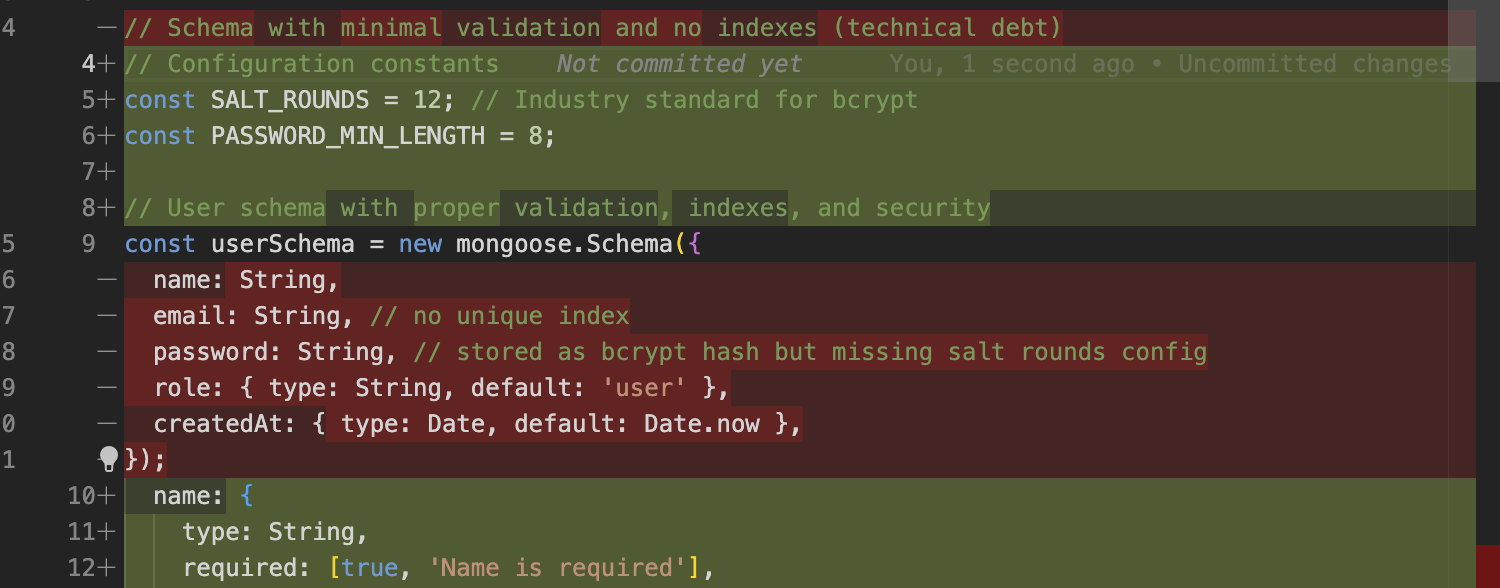
In this case, Qodo flagged that the schema was storing passwords without proper bcrypt configuration, missing salt rounds, and no unique email index. It recommended industry-standard fixes, like enforcing password length, indexing email, and configuring salt rounds for stronger hashing. Again, I applied these changes directly from the chat UI in my IDE and the schema was instantly upgraded to follow secure practices without me needing to manually patch it line by line.
This shift-left approach, powered by Qodo’s deep codebase intelligence, ensured that required validation, security, and consistency fixes were made earlier in development. Instead of discovering these issues later in pull request, during integration, or in production, I resolved them upfront with a quick remediation.
How Qodo Strengthens Code Reviews Beyond the IDE
If there are any other issues that teams couldn’t catch in the IDE, code reviews in pull requests are a perfect place to prevent those issues. To get started, I made a pull request in GitHub of my changes against the main branch. Then, I asked Qodo Merge to tell me if there were any hardcoded values in my PR. Qodo didn’t just stop there. It went deeper into the schema changes and highlighted security, data integrity, and indexing concerns that could easily slip past manual reviews.

What Qodo gave me as output:
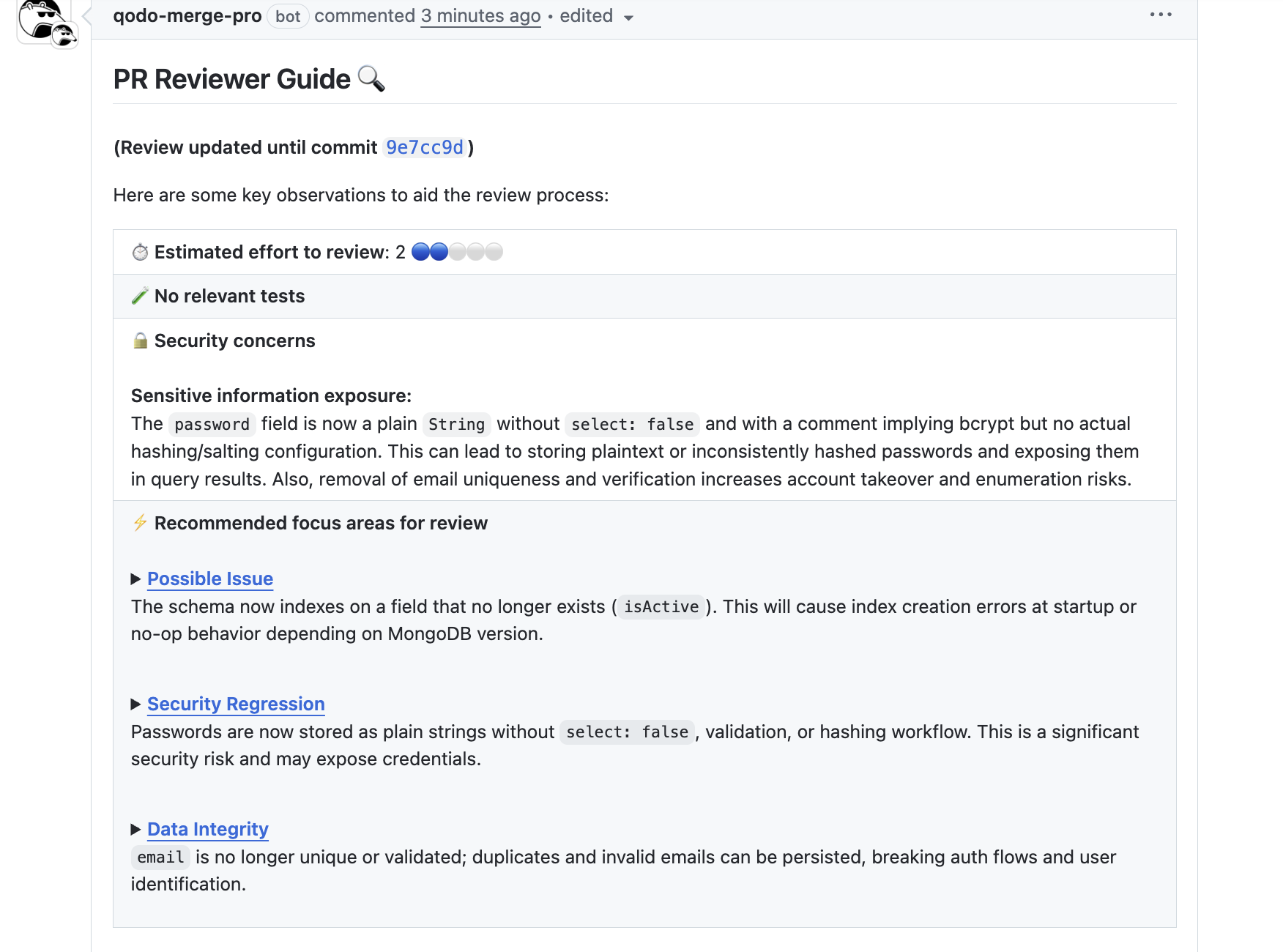
Qodo identified multiple technical debt risks introduced during a schema update in this review. For example, it flagged that the password field was reverted to a plain string without select: false, bcrypt hashing, or salting. This meant the schema was at risk of storing plain text or inconsistently hashed passwords while exposing them in query results.
On top of that, Qodo pointed out that email uniqueness and verification had been removed, creating a risk of account takeover and enumeration attacks. These are not issues that a developer would necessarily notice in an IDE, but they are brought up as integral blockers in a review context.
Another highlight was around data integrity and indexes. Qodo noticed that the schema was indexing on a field (isActive) that no longer existed. Depending on the MongoDB version, this would throw errors on startup or silently fail.
Some more review questions that I asked Qodo Merge:

Qodo gave me a list of all the areas with repeated logic blocks. On top of that, clicking each one lets you easily get suggestions on improving those issues, too. Have a look at the first issue, about token verification and refresh handling:

Qodo points out the files involved where the fix is recommended and an explanation of the issue here. The suggestions are clear, simple, and can be implemented easily by applying the fix with Qodo’s suggested code snippet change right in the pull request and crossing it off the list of suggested code changes.
What makes this especially powerful is Qodo’s use of best practices defined in a YAML file. Every review consistently enforces the same standards by encoding team-specific rules and security requirements in configuration.
Instead of relying on each developer’s personal checklist, Qodo ensures things like password hashing, email validation, and index consistency are always verified. This shift-left review process supports teams throughout the SDLC by reducing reliance on late-stage QA or ops fixes and ensuring every PR aligns with architectural and security expectations.
Conclusion
Technical debt is not just a theoretical concept; it’s a tangible cost teams pay when shortcuts accumulate over time. As I shared in the opening story, even a “temporary” workaround can cascade into outages, performance issues, and frustrated users. In today’s development landscape, AI coding assistants add a new layer to this problem.
While AI can accelerate feature delivery and reduce repetitive work, it does so without understanding the nuances of your codebase, architecture, or business logic. This makes it easy for hidden flaws, duplication, and inconsistencies to creep in, quietly increasing technical debt.
Tools like Qodo help teams manage this “last mile” by providing context-aware reviews, one-click remediation, and deeper code understanding. By focusing on the 20% of code that determines mergeability and readiness, Qodo helps AI-assisted development move faster while keeping code clean, secure, and ready for production
FAQs
What is Technical Debt, and Why Should Teams Care?
Technical debt comes up when shortcuts or suboptimal solutions are taken during development. Over time, it slows feature delivery, increases bugs, and raises maintenance costs. Proactively managing it ensures your software remains scalable, maintainable, and production-ready.
How Does AI Generated Code Impact Technical Debt?
AI can speed up coding by generating functional code quickly, but it often lacks context and architectural understanding. This can introduce duplication, hidden bugs, and inconsistencies, which silently accumulate as technical debt if not reviewed carefully.
How Can Qodo Help Teams Manage AI Generated Technical Debt?
Qodo provides context-aware code reviews that catch subtle errors, duplication, and architectural inconsistencies. Its one-click remediation and prioritized suggestions help teams maintain production-ready code while minimizing hidden debt.
Can Qodo Be Integrated Easily Into Existing Developer Workflows?
Yes. Qodo works directly with pull requests, IDEs, and CLI tools, providing real-time feedback. This ensures developers receive guidance at every stage, making reviews consistent and code quality easier to maintain across the team.
What Makes Qodo Different From Traditional Code Review Tools?
Qodo understands your codebase’s architecture, dependencies, and coding patterns, in contrast to standard tools. It focuses on the 20% of code determining mergeability and production readiness, helping teams prioritize fixes that reduce technical debt.



